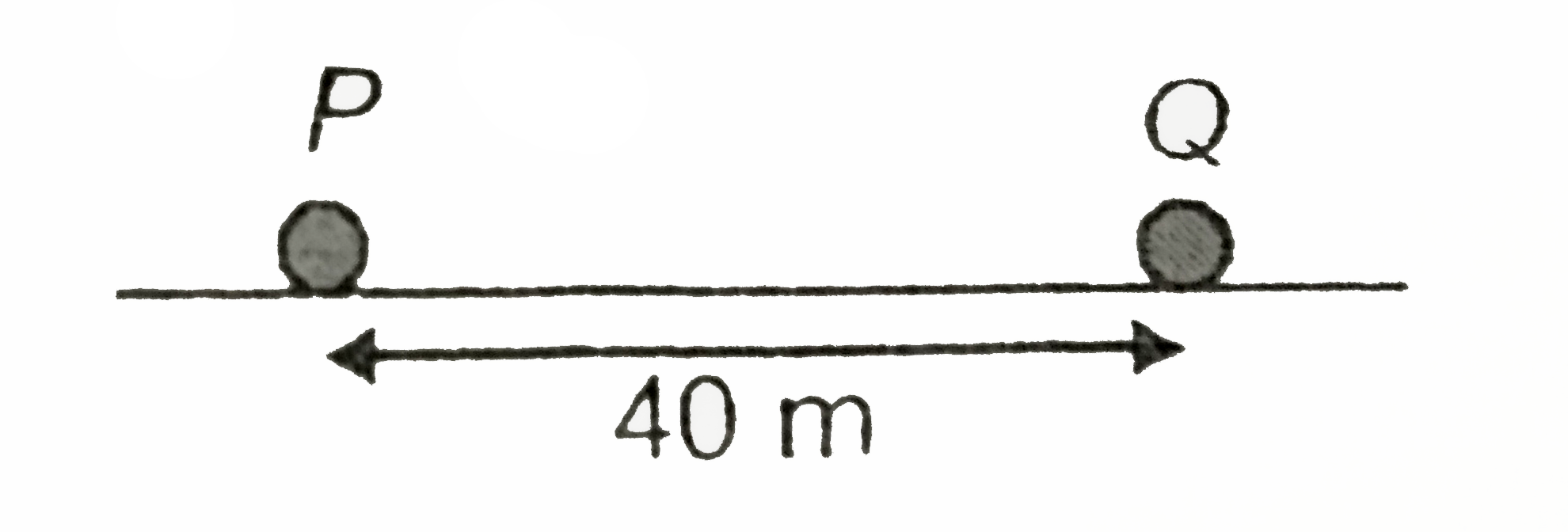A man is 45 m behind the bus when the bus starts acceleration from rest with acceleration 2.5ms2. With what minimum velocity should man start running to catch the bus?
12 m/s
14 m/s
15 m/s
16 m/s
The correct Answer is:C
To solve the problem of how fast the man should run to catch the bus, we can use the equations of motion. Here’s a step-by-step solution:
Step 1: Understand the situation
The bus starts from rest and accelerates at 2.5m/s2. The man is initially 45m behind the bus. We need to find the minimum velocity with which the man should start running to catch the bus.
Step 2: Write down the equations of motion
For the bus, which starts from rest and accelerates:
- Initial velocity ub=0
- Acceleration ab=2.5m/s2
- Distance covered by the bus in time t is given by:
sb=ubt+12abt2=0+12(2.5)t2=1.25t2
For the man, who starts running with an initial velocity um and accelerates at 0m/s2 (constant speed):
- Distance covered by the man in time t is:
sm=umt
Step 3: Set up the equation to catch the bus
The man needs to cover the initial 45m gap plus the distance the bus travels in the same time t:
sm=sb+45
Substituting the equations from above:
umt=1.25t2+45
Step 4: Rearranging the equation
Rearranging gives:
1.25t2−umt+45=0
This is a quadratic equation in t.
Step 5: Use the discriminant for minimum velocity
For the man to catch the bus, the quadratic equation must have real solutions, which means the discriminant must be greater than or equal to zero:
D=b2−4ac
Here, a=1.25, b=−um, and c=45:
D=(−um)2−4(1.25)(45)≥0
u2m−225≥0
u2m≥225
Step 6: Solve for um
Taking the square root:
um≥15m/s
Conclusion
The minimum velocity with which the man should start running to catch the bus is 15m/s.
---
The bus starts from rest and accelerates at 2.5m/s2. The man is initially 45m behind the bus. We need to find the minimum velocity with which the man should start running to catch the bus.
For the bus, which starts from rest and accelerates:
- Initial velocity ub=0
- Acceleration ab=2.5m/s2
- Distance covered by the bus in time t is given by:
sb=ubt+12abt2=0+12(2.5)t2=1.25t2
- Distance covered by the man in time t is:
sm=umt
The man needs to cover the initial 45m gap plus the distance the bus travels in the same time t:
sm=sb+45
Substituting the equations from above:
umt=1.25t2+45
Rearranging gives:
1.25t2−umt+45=0
This is a quadratic equation in t.
For the man to catch the bus, the quadratic equation must have real solutions, which means the discriminant must be greater than or equal to zero:
D=b2−4ac
Here, a=1.25, b=−um, and c=45:
D=(−um)2−4(1.25)(45)≥0
u2m−225≥0
u2m≥225
Taking the square root:
um≥15m/s
The minimum velocity with which the man should start running to catch the bus is 15m/s.
Similar Questions
A man is 10m behind the bus stop when the bus left the stop, with an acceleration of 2m/s2 . What should be the minimum uniform speed of man so that he may catch the bus? If he runs with required minimum speed then how much time it will take to catch the bus?
View SolutionA boy is moving with constant velocity v0on a straight road. When he is at a distance d behind the bus, the bus starts from rest and moves with a constant acceleration α. Find the minimum value of v0 so that the boy catches the bus.
View Solution
Knowledge Check
A man is d distance behind the bus when the bus starts accelerating from rest with an acceleration a0. With what minimum constant velocity should the man start running to catch the bus
A√4a0dB√3a0dC√2a0dD√a0dA man is 25 m behind a bus, when bus starts accelerating at 2ms−2 and man starts moving with constant velocity of 10ms−1. Time taken by him to board the bus is
A2 sB3 sC4 sD5 sA student is standing at a distance of 50 metres from a bus. As soon as the bus begins its motion (starts moving away from student) with an acceleration of 1ms−2, the student starts running towards the bus with a uniform velocity u . Assuming the motion to be along a straight road. The minimum value of u, so that the student is able to catch the bus is :
A5ms−1B8ms−1C10m/s−1D12m/s−1
A man is l=9 m behind the door of a train when it starts moving with acceleration a=2m/s2.The man runs at full speed. How far does he have to run and after what time does he get into the train ? What is his full speed ?
View SolutionA man is l=9m behind the door of a train when it start moving with acceleration a=2ms2. The man runs at full speed. How far does he have to run and after what time does he get into the train ? What is his speed ?
View SolutionA man 16m behind the door of a train when it starts it starts moving with an acceleration a=2ms−1.The man runs with a msximum constant speed to get into the train. How for does he have to run and after what time does he get the train ? What is his maximum constant speed ?
View SolutionTo particles P and Q are initially 40 m apart P behind Q. Particle P starts moving with a uniform velocity 10 m/s towards Q. Particle Q starting from rest has an acceleration 2m/s2 in the direction of velocity of P. Then the minimum distance between P and Q will be

View SolutionA bus is moving with a velocity 10ms−1 on a straight road. A scooterist wishes to overtake the bus in 100s. If the bus is at a distance of 1km from the scooterist, with what velocity should the scooterist chase the bus ?
View Solution
